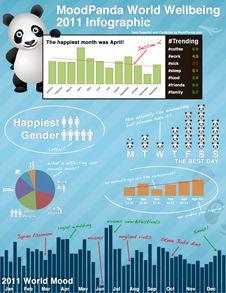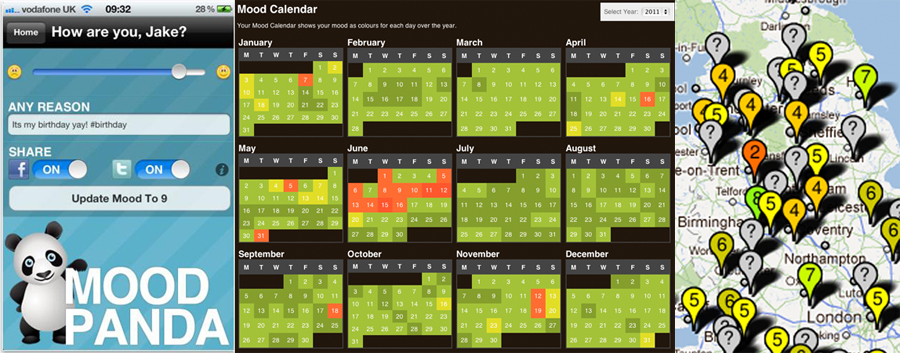Toolmaker Talk: Ross Larter (MoodPanda)
Rajiv Mehta
February 1, 2012
About three years ago, Gary Wolf wrote a detailed post on Measuring Mood — some tools are complicated enough to get you grouchy! Gallup goes through a lot of trouble to gauge the US happiness level on a daily basis. Others take a simple approach, such as Eric Kennedy’s recent talk at the Seattle QS meetup on Tracking Happiness.
 Ross Larter believes an emphasis on simplicity and community (especially of people who you don’t know elsewhere) has been key to broad acceptance of his happiness-tracking MoodPanda.
Ross Larter believes an emphasis on simplicity and community (especially of people who you don’t know elsewhere) has been key to broad acceptance of his happiness-tracking MoodPanda.
Q: How do you describe MoodPanda? What is it?
Larter: MoodPanda.com is a mood tracking website and iphone app. Tracking is very simple: you rate your happiness on a 0-10 scale, and optionally add a brief twitter-like comment on what’s influencing your mood.
MoodPanda is also a large community of friendly people, sharing their moods, celebrating each others’ happiness, and supporting each other when they’re down.
People post many times a day – some tracking their mood from the moment they wake to the point their head hits the pillow at night! We organize people’s posts into their personal mood diary where they can view it many different ways: graphically, as a mood feed, broken down by metrics and even location based on a map.
Q: What’s the back story? What led to it?
Larter: MoodPanda got started in a pub in Bristol, England. A friend was asking people round the table how their day was and somebody replied with a 10/10. My response was if today was the best day ever what happens if tomorrow is the same as today but then something else amazing happens (I think it included the “pussy cat dolls”), and we chatted for a while on this. The next day I started thinking about the question and told Jake (Co-Founder) about the idea and it went from there. We both work in software development so building the site was not an issue.
We are on MoodPanda version 3 at the moment. For the first 2 versions of the site we built it to track just your own mood. It was only once we added commenting and “hugs” to the current version that we realised that people wanted the interaction with each other. This is when our user based really started to grow.
Q: What impact has it had? What have you heard from users?
Larter: Since the iPhone app has gone live it is growing quickly with many thousands of new user every month, over 60% now come from the Apple app store. We’re seeing about 1000 active user ratings a day. Hugs are a very popular feature. Panda users give out hundreds a day.
One thing we’ve learned is that there seems to be a strong demand for a place online where people can share their feelings with others who don’t know them in “real life”, people who won’t judge them. We see this in the data: only about 35% of mood ratings are passed through to Facebook and only 2% to Twitter. And we’ve heard this directly from users who have posted that its nice to talk to people that are interested in mood and wellbeing and don’t judge them.
Feedback from users has been fantastic, and in some cases very heartwarming. We’ve even had users tell us that they’ve “lived with years of hurt until they discovered MoodPanda”.
 We’ve now got so many users in the UK that our mood map is pretty representative. Our UK live mood map was quite similar to the UK Government official one from last year. We also put together a nice infographic of all of our data from 2011.
We’ve now got so many users in the UK that our mood map is pretty representative. Our UK live mood map was quite similar to the UK Government official one from last year. We also put together a nice infographic of all of our data from 2011.
We are always trying out new ideas, and some have not been well received. We had done some complicated graphs and visualization in the past, and we’ve learned that keeping it simple is the key to moodpanda.
I also never quite realised how much time is needed after all the technical work is done. I spend a ton of time talking on the radio, public speaking, blogging, twittering, etc. about MoodPanda.
Q: What makes it different, sets it apart?
Larter: What makes MoodPanda stand apart are its simplicity and community. Other mood tracking apps are very clinical and can often be intimidating to people first trying to track their mood. We keep it simple: rate your happiness from 0-10 and, if you want, say a few words about what is influencing your mood. The design and ethos of MoodPanda has been carefully cultivated to create a friendly, open and easy first step into happiness tracking.
The large community of “moody pandas” is the other major feature, as other mood tracking apps (like our first 2 versions) are private. We of course have users who want to remain private, but 92% of our users are posting as part of of the community. We have people giving “panda hugs” and commenting with help and advice constantly in the site and genuine caring friendships are being formed constantly. We’re working hard to understand what helps this community aspect of MoodPanda and build on it.
Q: What are you doing next? How do you see MoodPanda evolving?
Larter: We recently started tracking hashtags so we could do stats on the sentiment of people’s comments that linked to the mood ratings. We’ve found that #coffee, #friends, and #food are associated with more happiness, and #sick and #work with less. We’re wondering whether we will learn whether some brands are strongly associated with mood (for example whether new #coke is good or bad) in ways that you can’t learn from normal brand sentiment tools.
We are working on the android app, and we’ve got a lot of ideas in the development pipeline involving more community features and technologies like an API.
Jake and I still have to go to work at our day jobs, but MoodPanda is a project that we both care deeply about. We’ve set a budget of $100 a month to spend on MoodPanda, so we do everything ourselves and get as creative as we can.
Q: Anything else you’d like to say?
Larter: Just a big thanks to you guys and girls at quantified self, its nice to talk to others that are as excited and interested in QS, if people continue to use moodpanda it to make themselves happier, we know we have done a good job!
Product: MoodPanda
Website: http://moodpanda.com
Platform: web, iPhone
Price: free
This is the ninth post in the “Toolmaker Talks” series. The QS blog features intrepid self-quantifiers and their stories: what did they do? how did they do it? and what have they learned? In Toolmaker Talks we hear from QS enablers, those observing this QS activity and developing self-quantifying tools: what needs have they observed? what tools have they developed in response? and what have they learned from users’ experiences? If you are a “toolmaker” and want to participate in this series, contact Rajiv Mehta at rajivzume@gmail.com



